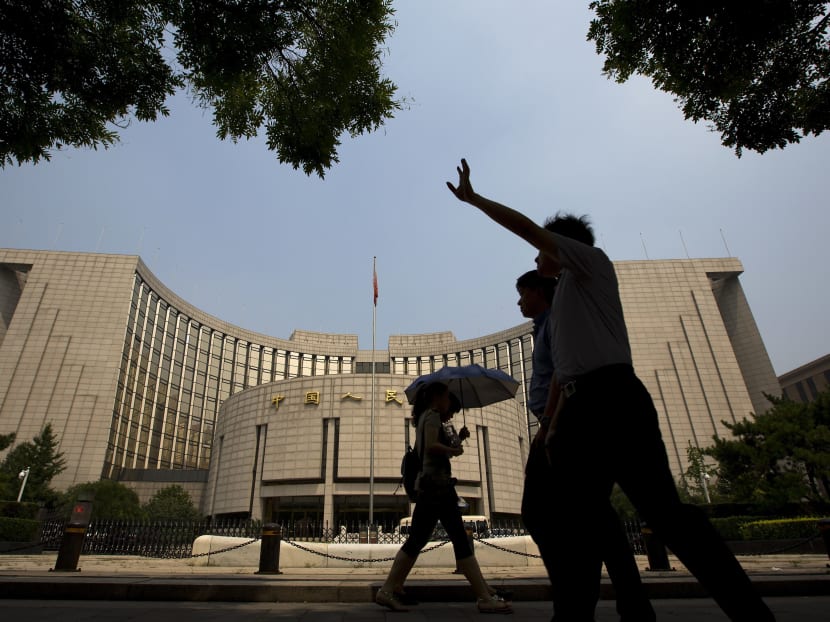PBOC intensifies assault on financing costs with cash injections
SHANGHAI — China’s central bank brought out an array of tools to target stubbornly high financing costs this week, reducing interest rates, offering cheap loans and adding cash to the financial system through open-market operations.

People walk past China's central bank in Beijing on Aug 11, 2015. Photo: AP
SHANGHAI — China’s central bank brought out an array of tools to target stubbornly high financing costs this week, reducing interest rates, offering cheap loans and adding cash to the financial system through open-market operations.
Money-market rates are finally buckling under the pressure, with the overnight rate breaking a record 39-day run of increases and interest-rate swaps slipping to the lowest since July. Supply of cash has lagged demand especially since a shock Aug 11 yuan devaluation that saw the People’s Bank of China buying the currency on subsequent days to lend it stability.
The monetary authority auctioned 150 billion yuan (S$32.8 billion) of seven-day reverse-repurchase agreements today (Aug 27), according to a statement on its website. It added the same amount on Tuesday, leaving a net addition of 210 billion yuan for the past two weeks, the most for open-market operations since February.
“Such big amounts before the effective date of a reserve-requirement-ratio cut shows the central bank hopes to stabilize funding costs amid outflow pressure,” said Mr Li Qilin, a fixed- income analyst at Minsheng Securities, referring to a reduction in bank reserve ratios that will be implemented Sept 6. “By lowering the reverse-repo rate, the central bank is trying to cut borrowing costs to support the economy.”
The cost of one-year interest-rate swaps, the fixed payment to receive the floating seven-day repos, fell 13 basis points to 2.42 per cent so far this week as of 10.27 am in Shanghai, data compiled by Bloomberg show. They were little changed for the day. The overnight repo rate, a gauge of interbank liquidity, has dropped 16 basis points in the past two days to 1.70 per cent. The seven-day fell 25 basis points to 2.30 per cent.
PBOC Pressure
The central bank reduced its one-year lending and deposit rates by 25 basis points each to 4.6 per cent and 1.75 per cent, respectively, effective yesterday. It lowered the reserve ratio for all banks by 50 basis points. It also added funds to the financial system by offering 140 billion yuan of six-day loans at a 2.3 per cent rate through its Short-term Liquidity Operations facility.
It sold 60 billion yuan of three-month treasury deposits on Aug 25 on behalf of the Ministry of Finance. The 3 per cent interest paid was the least since 2010, data compiled by Bloomberg show. The PBOC will auction another 60 billion yuan tomorrow. The rate on the seven-day repos offered today was 2.35 per cent, lower than Tuesday’s 2.50 per cent.
The central bank also provided 110 billion yuan of six- month loans to 14 financial institutions via its Medium-term Lending Facility last week. It gauged demand for additional funds this week, according to people familiar with the matter.
Yuan, Stocks
China’s Aug 11 devaluation of the yuan and a simultaneous shift to a more market-oriented exchange rate triggered the currency’s steepest slide in two decades and raised concern about similar moves in the region. Under the new system, PBOC intervention has partly replaced the daily reference rate’s role in guiding currency moves, which contributed to liquidity tightness in the market.
The Shanghai Composite Index of stocks rose 1.3 per cent today, after tumbling 25 per cent since the yuan devaluation. China’s reserve-ratio cut will release 750 billion yuan into the financial system, according to an estimate by Barclays.
“Following the double cuts, the liquidity tightness will be alleviated temporarily,” SWS Research analysts including Shanghai-based Chen Kang wrote in a note. “The PBOC is using various tools to ensure money supply and keep funding costs in a desirable range. Further injections are likely.” BLOOMBERG





